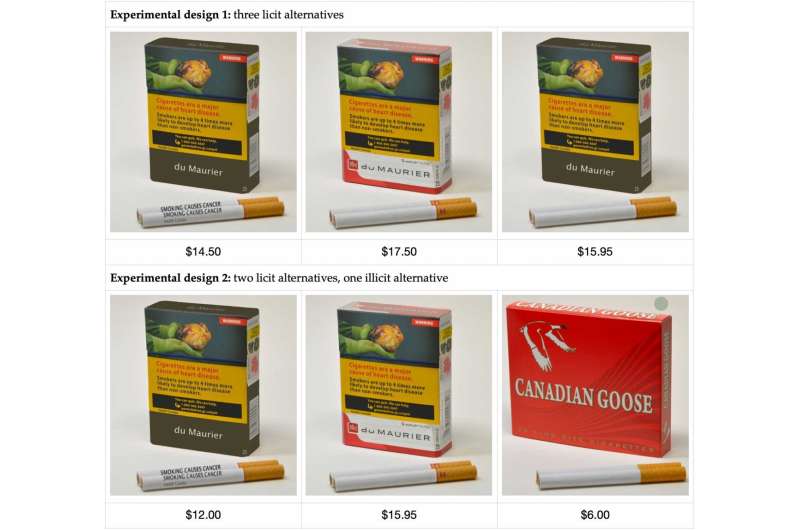This article has been reviewed according to Science X's editorial process and policies. Editors have highlighted the following attributes while ensuring the content's credibility:
fact-checked
trusted source
proofread
Study finds price is main factor in cigarette choice among Canadian smokers

Tobacco use is the leading cause of preventable deaths and illness worldwide. In 2019 , smoking and exposure to second-hand smoke accounted for nearly nine million deaths, equivalent to 15% of all deaths that year.
A study from City, University of London, McMaster University and York University in Canada, suggests that price is the main reason for cigarette choice among Canadian smokers, over and above health warnings on the product and packaging. The findings are published in the journal Economics & Human Biology.
In Canada, the government has taken actions to reduce the number of its smokers for decades, yet questions still persist as to how to further positively influence more Canadian smokers' decision to quit.
In November 2019, it became the country with the most comprehensive cigarette packaging regulations to help curb their use. These regulations require a drab brown color for all packs, eliminate branding elements, and feature large health warnings covering significant portions of the packaging.
Further, in June 2022, Canada proposed an innovative regulation to print health warnings on individual cigarettes, a measure that came into effect in August 2023 and is being implemented gradually.
What happened in the study?
The researchers wanted to answer two questions:
- What attributes of packets of cigarettes affected study participants' likelihood of purchasing them?
- What attributes of cigarette packets affected study participants' perception of them being a risk to their health?
The study involved a choice experiment completed by 551 participants from an ongoing online survey panel of adult smokers in Ontario, Canada.
About a third of respondents were male, with an average (mean) age of 50 years old. Some 85% were daily smokers, about three out of four smoked within an hour of waking up, two thirds had tried to quit smoking in the previous year, and about one in five had used an electronic cigarette within the previous month.
In this experiment, each participant was presented with four options to choose from. Three of them would be packets of cigarettes, which varied between each other in branding of the packaging, price, with some options having cigarettes printed with a health warning on each stick. There was also a fourth option not to smoke at all.
This exercise was repeated six times by each participant, with each presentation consisting of three choices of cigarette they had not seen before.
Some of the respondents were provided with options for three licit (legally bought) packets of cigarettes, and an option not to smoke, while others were provided with two licit options and an illicit (illegally bought) packet of cigarettes, and an option not to smoke.
The study used a type of analysis called 'latent class analysis' which allowed the researchers to quantify different patterns of preferences with respect to the various attributes of the cigarettes and cigarette packs respondents' had been presented with
What did the study find?
Findings from the analysis suggest that almost half of those respondents given the option would choose a cheaper, branded, illicit packet of cigarettes without any warnings on the packet, over any legal packet of cigarettes they were able to choose from.
For about one in five respondents, plain packaging and especially a warning printed on each cigarette stick reduced the likelihood of them stating a purchasing preference for one of these options.
About a third of respondents chose from their options almost solely with price in mind, i.e. chose the cheapest option.
Crucially, none of the attributes of a cigarette packet that the researchers looked at seemed to affect participants' perception of its risk to their health.
What does this mean?
It seems that pricing of the cigarettes was the clear factor that influenced participants' purchasing decision, and that higher price (e.g. through high taxation) appears to be the most effective deterrent for dissuading this sample of smokers not to buy them, and could be applied to smokers more widely.
The study highlights how reducing the availability of illicit cigarettes on the market could have a positive effect on smokers' consideration to purchase as that is the cheapest option.
It further suggests that the fact smokers' perception of health risk seemed unaffected by any measures taken to influence it in the study is a reflection partly of their age—having already been exposed to stringent smoking regulations over a long period of time (decades), but also the fact that most of them were trying to quit already, and hence well aware of the risks to their health.
Co-author of the study Emmanouil Mentzakis, Professor, Department of Economics, City, University of London, explains, "Effective smoking cessation policies require bold, holistic approaches. To truly curb smoking, interventions must eliminate its marketing allure, explicitly communicate its risks and consequences and, most importantly, restrict access to tobacco products, either through price hikes or limiting availability.
"Prices and availability are the most effective strategies simply because they target the two core resource constraints most people face: money and time. Policies that overlook these two critical elements are likely to fail. The successful alcohol regulation both in Canada and the UK has paved the way for such policies to be adopted for tobacco."
More information: G. Emmanuel Guindon et al, Cigarette packaging, warnings, prices, and contraband: A discrete choice experiment among smokers in Ontario, Canada, Economics & Human Biology (2023). DOI: 10.1016/j.ehb.2023.101340



















